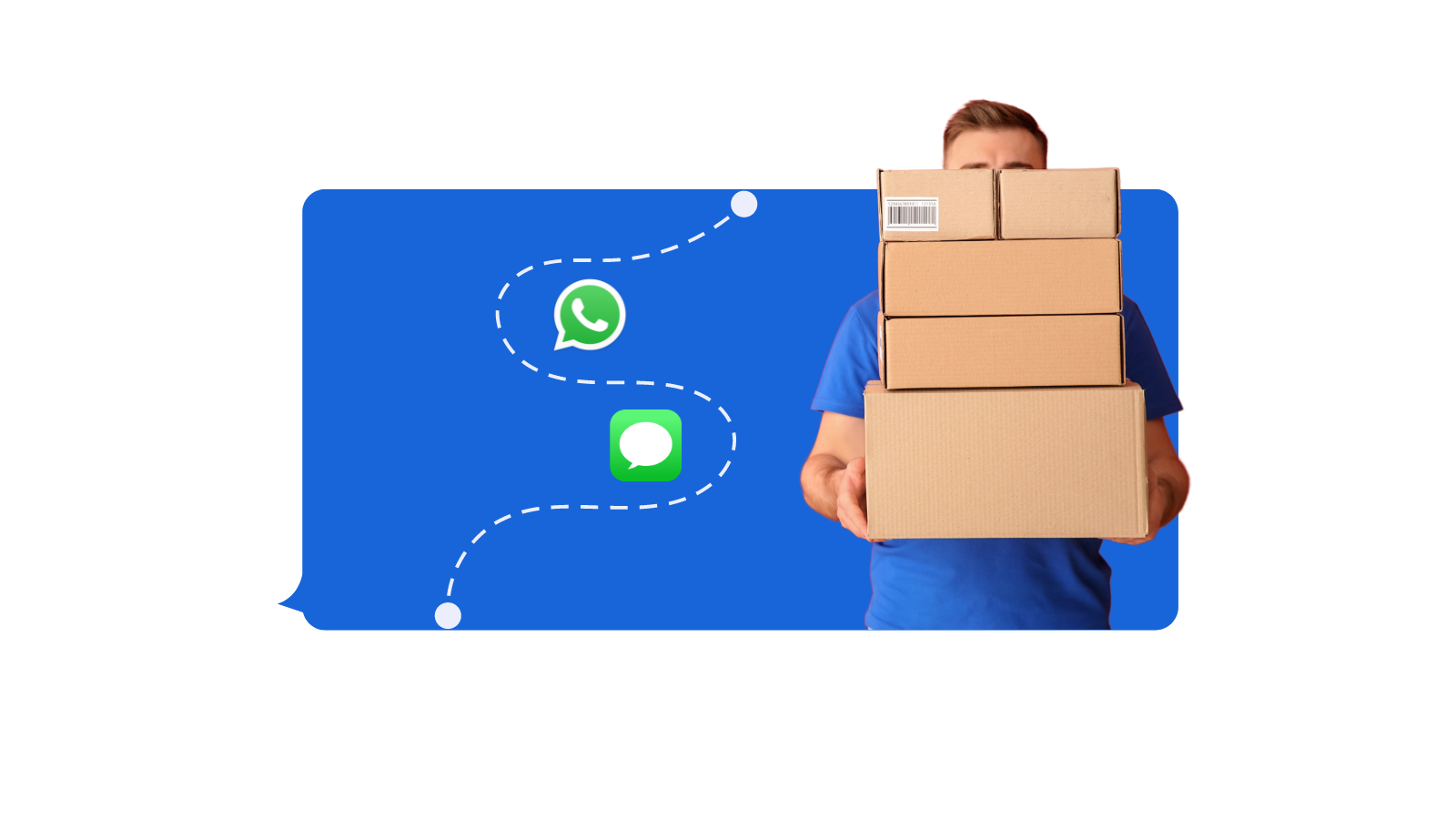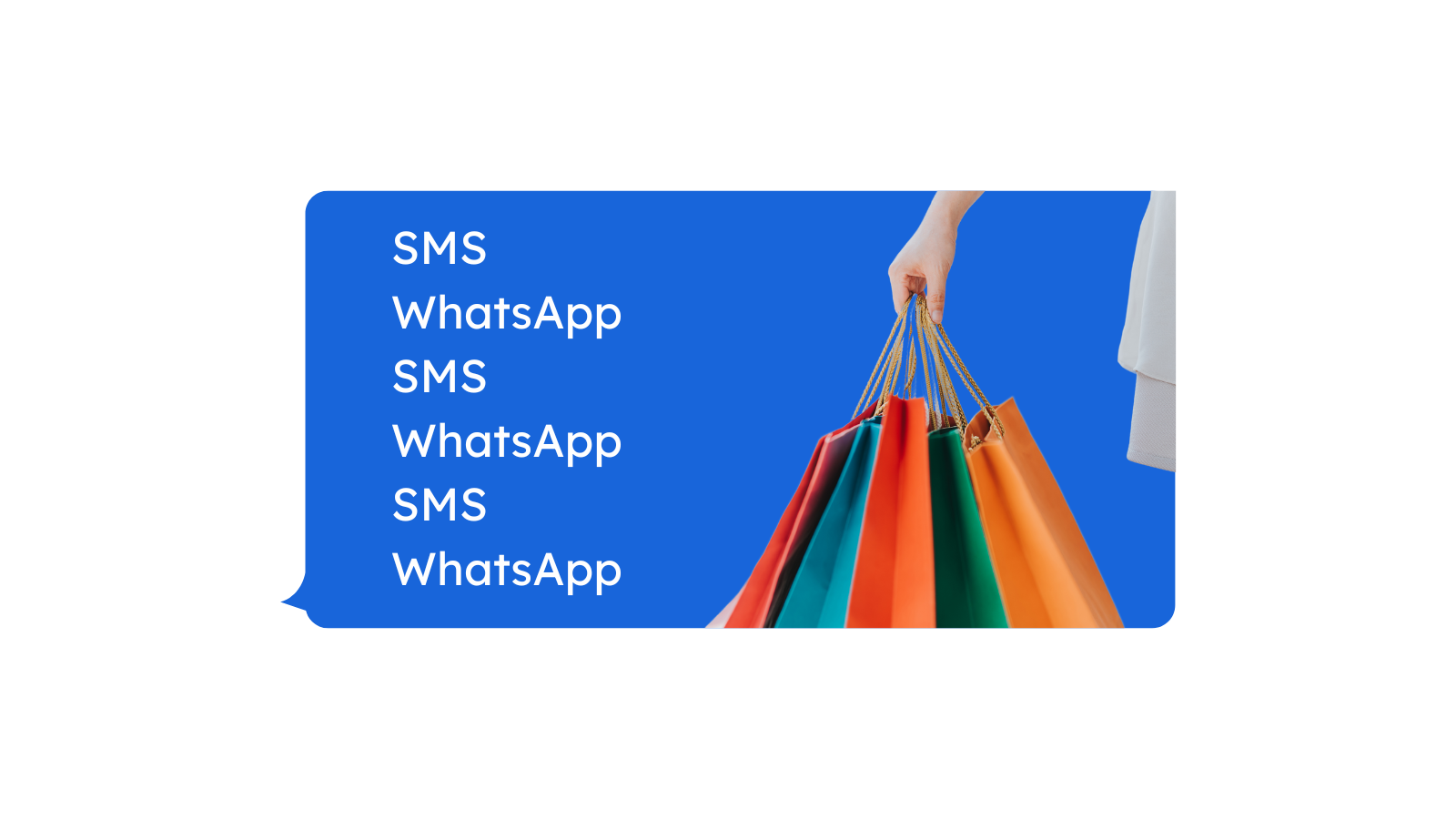Conversational commerce: Combining SMS and WhatsApp for e-commerce and marketing purposes

You don't have to choose between SMS and WhatsApp; instead, you can seamlessly integrate both to maximise your communication options. By using SMS for quick, universal messages and WhatsApp for richer, feature-packed conversations, you get the best of both worlds. However, it is very understandable that you might have questions about the implications of this combination and how to realise the use of it. Let’s dive into a detailed customer journey to illustrate the synergy between SMS and WhatsApp.
SMS and WhatsApp have a synergistic effect on the customer experience
SMS is highly effective for initial outreach due to its high open rates. Businesses can send promotional messages, alerts, or reminders to customers, encouraging them to engage further. Once initial contact is made, customers can be invited to continue the conversation on WhatsApp, where richer media and more interactive features are available. For inspiration, we have outlined a customer journey where SMS and WhatsApp complement each other.
Back-in-store alert via SMS
Sara submitted her number to receive a back-in-store alert as she wanted this sneaker, but her size wasn’t available at the moment. SMS is the perfect channel for this because the consumer wants to take direct action as soon as the sneaker is available again. Sending this via WhatsApp or email would be less effective as notifications can be hidden and both email and WhatsApp inboxes are flooded with other messages or personal communication. With an average open rate of 98%, SMS is the perfect channel for these types of alerts.
SMS Message: “Your favourite sneakers are back in store! Get them quickly while they last. Shop now at [store link]. 🛒✨”
Detailed summary and information on order via WhatsApp
Shortly after the purchase, the customer receives a detailed order summary on WhatsApp and email. The summary via WhatsApp is a point in the customer journey to increase the order size.
WhatsApp Message: “Hi [Name], thanks for your order #[Order ID]! Here are the product details and shipment details: [link to order summary on website]. We noticed you also browsed other products. Please note that you can still add products to your order for 1 more hour! Here’s some of the products you liked: [Product Images based on likes]”
This way, you can use WhatsApp as a marketing tool to increase the order size. You could even add a discount code to the WhatsApp message to influence people to increase the order size. WhatsApp is a perfect channel for this step because it allows you to show images as well as longer text options.

Shipping confirmation via WhatsApp or SMS
When the order is shipped, the customer receives an SMS with tracking information. As this is more of a service notification, you can use the channel they prefer. Both SMS and WhatsApp are very suitable for sending a shipping confirmation.
Sending shipping confirmations can reduce stress on the customer service departments as you can then mention that it’s out of your hands, it’s now up to the delivery company to get the product to the consumer as fast as they can.
SMS Message: “Good news, [Name]! Your order #[Order ID] has been shipped. Track your package here: [tracking link]."
Detailed feedback and generating reviews via WhatsApp
On the day of the delivery confirmation, the customer receives a WhatsApp text message asking for detailed feedback and offering support if needed. Because consumers are very engaged with the products bought in your webshop when they arrive, e-commerce businesses should utilise that most effectively. Not only can you easily know your NPS, but at this moment in the customer journey, you can also easily generate product reviews. Next to that, it’s an opportunity to catch negative feedback in the heat of the moment to avoid reputation damage. WhatsApp is the perfect channel for that because it offers two-way communication.
WhatsApp Message: “Hi [Name], your order #[Order ID] has arrived! Please rate your shopping experience from 1-5 stars.”
This helps gauge customer satisfaction and encourage immediate feedback.
If positive feedback:
WhatsApp Message: We’re glad you liked shopping with us! We’re currently generating reviews of products on our website. Help inspire others by reviewing [Product 1]. This month we’re giving away 10 vouchers of €100,- among product reviewers on our website!”
If negative feedback:
WhatsApp Message: “We’re sorry you hear that you rated our shopping experience lower than average. Can you please share what influenced your experience? [Shipping], [Product Quality], [Bad Service]. Would you like to speak to an agent to solve anything for you? [Yes] [No]"
Connecting this person to an agent via WhatsApp can help them communicate their dissatisfaction immediately. This means that if your agent is able to solve their problem quickly, the spread or growth of negative reputation against your company can be decreased or purely prevented. In addition, this could even end-up in a boost of your reputation.
Opt-in via SMS for a recurring newsletter via WhatsApp
We all enjoy sending monthly newsletters about new products, campaigns, launches, or events. However, email newsletters are facing decreasing open and engagement rates due to overcrowded inboxes. This doesn’t mean you should stop sending emails, but it does mean you should diversify your communication strategy, for example, by using WhatsApp.
Done right, this approach can make your brand feel like a ‘friend’. When people opt-in for a recurring newsletter via WhatsApp, you're entering their personal space. WhatsApp is commonly used for conversations with friends and family, so receiving regular updates from a brand on this platform feels more personal and friendly.
SMS Message: “Stay updated with our latest products, campaigns, and events! Subscribe to our WhatsApp newsletter for exclusive content, VIP access to price reductions and trend updates. Click here to sign up: [Sign-Up Link] 📲.” - This personal touch enhances customer loyalty and engagement."
WhatsApp Message: “Hi there! 👋 Thank you for subscribing to our WhatsApp newsletter. As a token of our appreciation, here's a €5 discount code for your next purchase of €50 or more: THANKYOU5. Enjoy exclusive updates, offers, and more. If you ever have any questions or need assistance, feel free to reach out to us here too. Best regards, [Your Brand Name]”
Shopping recommendations via WhatsApp

A few days after the order has been shipped, the customer receives personalised product recommendations based on their purchase. WhatsApp is a perfect channel for this use case as it offers the possibility to show the products visually, which has a positive impact on buying conversion.
WhatsApp Message: “Hi [Name], we hope you’re enjoying your recent purchase! Based on your order, we thought you might like these items: [link to recommendations with images]. You can find more information on this page [link to webshop].”
Reactivation through discount codes via SMS
If the customer doesn’t make another purchase for two months, they receive an SMS including a discount code for their next purchase from the webshop. You’re now using SMS because the customer is no longer engaged and continuously sending messages via WhatsApp might come across as intriguing a personal space. On top of that, SMS ensures a higher visibility.
SMS Message: “Hi [Name], you can now enjoy 10% off your next purchase with code SAVE10. Shop now: [link]. Your code is valid for 31 days.”
This timely reminder re-engages inactive customers.
Now you have sent a chain of SMS and WhatsApp messages to your customer. What did this do?
Through this chain of diverse communication, you achieved a bunch of things. Firstly, you made sure that your customer did not receive message after message on the same platform. This helps with reducing the spam feeling. Second, you were able to be in communication with them through the whole process, this means that they received personalised communication leaving them more engaged with your company and your products. Thirdly, they received information about further purchases through visual content and were kept interested through discount codes.
Through this communication chain, you most likely gained yourself a loyal customer that feels welcome to communicate with your employers and ask any questions regarding doubts they might have about purchases they are considering. What better way is there to achieve successful business messaging?
Where does email fit in this customer journey?
We hear you asking, "Where does email fit in this customer journey?" We firmly believe that email should always be a part of your strategy. While SMS and WhatsApp provide instant and engaging communication, email remains crucial for detailed information and newsletters. Integrating all three channels ensures comprehensive customer engagement. However, as inboxes become increasingly crowded, diversifying your communication channels is essential. By incorporating additional channels into your email strategy, you can enhance the success of your initial goals. While this approach may be more costly, it will undoubtedly increase your ROI.
Do you want to start combining SMS and WhatsApp now?
You can request a quote for both platforms through this link from Spryng. With Spryng, you can combine your messaging platforms through one trustworthy and secure portal.
If you have any questions now or during your new partnership with Spryng, you can contact one of our colleagues through our website. We are here to help 24/7 in English, Dutch, German, and French.
Ready to elevate your communication strategy? Request a quote from Spryng and start your free trial today.


